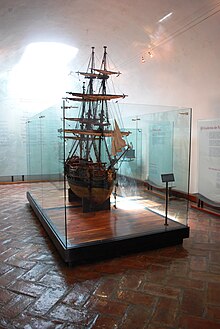Filipino immigration to Mexico
 Model of the ship San Pedro de Cerdeña on display at the San Diego Fort in Acapulco | |
| Total population | |
|---|---|
| 1,200 Filipino citizens living in Mexico. 8,100,000 Mexicans of filipino descent | |
| Regions with significant populations | |
| Jalisco, Michoacán, Guerrero and Colima | |
| Languages | |
| Spanish, English, Philippine languages | |
| Religion | |
| Predominantly Roman Catholicism | |
| Related ethnic groups | |
| Other Filipino diasporas |
Filipino Mexicans are Mexican citizens who are descendants of Filipino ancestry.[1] There are approximately 8,100,000 Mexicans of Filipino descent. Filipino nationals residing in Mexico are about 1,200.[2] In addition, genetic studies indicate that about a third of people sampled from Guerrero have Asian ancestry with genetic markers matching those of the populations of Indonesia and the Philippines.[3]
History[]
Most of their Filipino ancestors arrived in Mexico during the Spanish colonial period. For two and a half centuries, between 1565 and 1815, many Filipinos and Mexicans sailed to and from Mexico and the Philippines as sailors, crews, slaves, prisoners, adventurers and soldiers in the Manila-Acapulco Galleon assisting Spain in its trade between Asia and the Americas. Some of these sailors never returned to the Philippines. Most settled in and integrated into the Mexican society. In the late 19th and early 20th century some Filipinos came to Mexico as refugees from Spain during Francisco Franco’s dictatorship.[citation needed] These Filipinos were descendants of Filipino and Filipino mestizo settlers who entered Spain after the Spanish–American War.

Smaller waves of Filipino migration to Mexico took place in the late 19th and 20th centuries after the Philippines was annexed by the U.S. during the Spanish–American War of 1898–1900. A number of Filipino farm laborers and fishermen arrived to work in the Mexican west coast. These areas included the Baja California, Sonora and Sinaloa, while some had awaited to enter the United States to reunite with family members in Filipino American communities in California, and elsewhere. Mexican immigration law continues to grant special status for Filipinos.
Their descendants are found in communities particularly in the state of Guerrero, and Colima. Most of these individuals are mixed blood peoples, and trace half or a quarter of their ancestry and origin back to the Philippines during the Manila-Acapulco Galleon period.
Today, newly arrived Filipinos are overseas or contract workers who came to Mexico to obtain employment. Most of these individuals speak at least one of the Philippine languages.
Notable Mexicans of Filipino descent[]
- Ramón Fabié - Lieutenant Colonel commander of Miguel Hidalgo y Costilla
- Luis Pinzón - Military commander of José María Morelos
- Isidoro Montes de Oca – Mexican General and Lieutenant commander of Vicente Guerrero
- - Military commander of Vicente Guerrero
- Romeo Tabuena – painter and printmaker
- Alejandro Gómez Maganda – Governor of Guerrero (1951–1954)
- Lili Rosales – Representative of Mexico in the Reina Hispanoamericana 2011 beauty contest
- Anthony Padilla - Youtuber and Former Member of Smosh
- Arturo Mongoy - Grandson of Francisco Mongoy and member of 201st Fighter Squadron (Mexico)
See also[]
- Mexico–Philippines relations
- Manila galleon
- Mexican settlement in the Philippines
- Mestizos in Mexico
- Filipino mestizo
References[]
- ^ [1]
- ^ "Archived copy". Archived from the original on 2009-02-09. Retrieved 2017-02-15.CS1 maint: archived copy as title (link)
- ^ Latin America’s lost histories revealed in modern DNA By Lizzie Wade
External links[]
- Color Q World: Asian-Latino Intermarriage in the Americas
- Filipinos in Mexican History
- Afro-Filipino Mongoys (Photo of General Francisco Mongoy's descendants in the State of Guerrero)
- Insurgent Leaders during Mexican War of Independence against Spain
- Asian Mexican
- Filipino emigrants to Mexico
- Ethnic groups in Mexico
- Filipino diaspora by country
- Filipino Latin American
- Immigration to Mexico
- Mexico–Philippines relations
- Mexican people of Filipino descent
